There is no shortage of caterpillars in North Carolina! While some of these tiny explorers are harmless and fascinating to observe, others carry toxins that can be harmful to humans. In this article, we will discuss the various caterpillar species found in North Carolina while keeping an eye on poisonous ones. Let’s dive straight into this list of the intriguing and, at times, cautionary caterpillars of North Carolina!
1. Buck Moth Caterpillar (Hemileuca maia)

A venomous caterpillar that can inflict a sting, causing pain and swelling, is the buck moth caterpillar.
©iStock.com/Oleg Marchak
Buck moth caterpillars, which measure about two inches in length, exhibit a color spectrum from brown to a deep, purplish-black and have several yellow markings along their bodies. Their bodies are covered with forked black spines, often ending in red or black. These caterpillars tend to frequent oak or willow trees during spring to mid-summer.
They’re also part of a limited category of caterpillars possessing skin laden with venomous spines. On contact, these spines can trigger a severe skin rash and inflict a painful sting, resulting in immediate pain, intense itchiness, and swelling. So if you see a buck moth caterpillar in the wild, admire it from afar!
2. Pipevine Swallowtail Caterpillar (Battus philenor)

This interesting caterpillar almost looks extraterrestrial with its orange spikes.
©Sundry Photography/Shutterstock.com
You can identify pipevine swallowtail caterpillars by their purple bodies, accented with orange spots and long, thread-like protrusions.
These caterpillars are highly toxic. This is because they feed on Aristolochia plants that contain substances known as aristolochic acids. The pipevine swallowtail caterpillar consumes these plant leaves and accumulates the toxic acids, which it retains even as it metamorphoses into its pupal and adult butterfly.
3. Saddleback Caterpillar (Acharia stimulea)

With an eye-catching green “saddle” marking on their backs, the saddleback caterpillar is one of the most recognizable caterpillars found in North Carolina.
©Hagit Berkovich/Shutterstock.com
Saddleback caterpillars feature a distinct brown, saddle-like mark on their green bodies. Their nickname, “slug caterpillars,” stems from their atypical leg structure. Their belly legs lack the small hooks found in most caterpillars, and their six articulated legs are relatively short. They consume leaves from a wide variety of plants, including maples and gladiolas.
The caterpillar sports soft horns on both ends, covered, like the majority of its body, in hairs that produce poison. Touching these hairs can lead to a painful, inflamed skin rash and occasional nausea in humans.
4. Milkweed Tussock Caterpillar (Euchaetes egle)
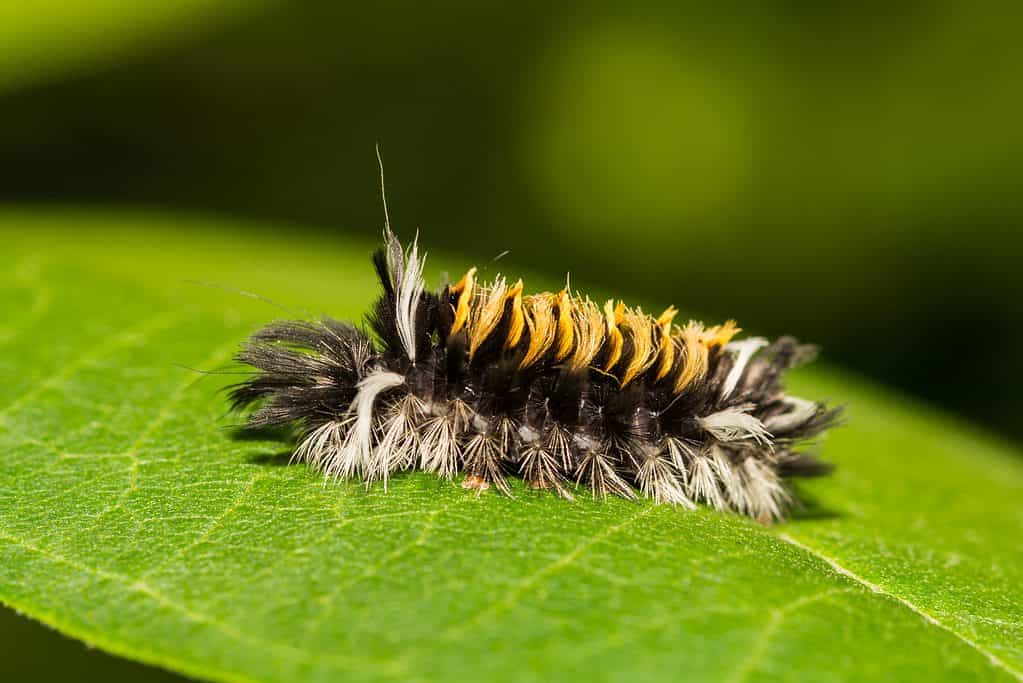
This fuzzy caterpillar eats milkweed and dogbane until it changes into the milkweed
tiger
moth.
©Jay Ondreicka/Shutterstock.com
While the adult milkweed tussock moth may not grab attention, its caterpillar form is quite eye-catching, blanketed with thick patches of black, orange, and white. Also known as the milkweed tiger moth, it feeds specifically on milkweeds and dogbanes during its larval stage.
The tussock moth is another toxic caterpillar species found in North Carolina. Their hairs can trigger skin irritation and assorted allergic reactions in people. They can also emit a foul substance that provokes nausea and vomiting. Though milkweed tussock moth caterpillars aren’t lethal, they can certainly cause substantial discomfort.
5. Spicebush Swallowtail Caterpillar (Papilio troilus)
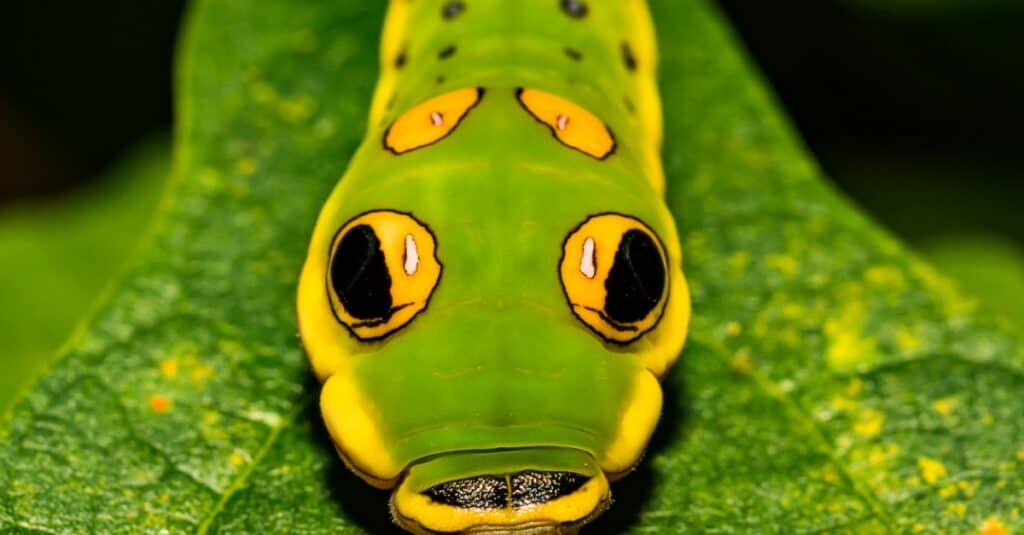
This caterpillar disguises itself as a snake to avoid predation. Despite this crazy camouflage, the spicebush swallowtail caterpillar is not harmful.
©iStock.com/JasonOndreicka
Spicebush swallowtail caterpillars cleverly use imitation as a defense strategy to evade common predators and tachinid flies, which significantly decreases their population.
This caterpillar is green, with a brown underbelly and prominent eyespots on its head.
Its resemblance to a tiny snake and bright camouflage hues help it to stay safe in various situations. Despite having two pairs of intimidating eyespots, these caterpillars pose no harm and are not poisonous. They typically feed on plants like sweet bay, spicebush, sassafras, and the tulip tree.
6. Common Buckeye Caterpillar (Junonia coenia)
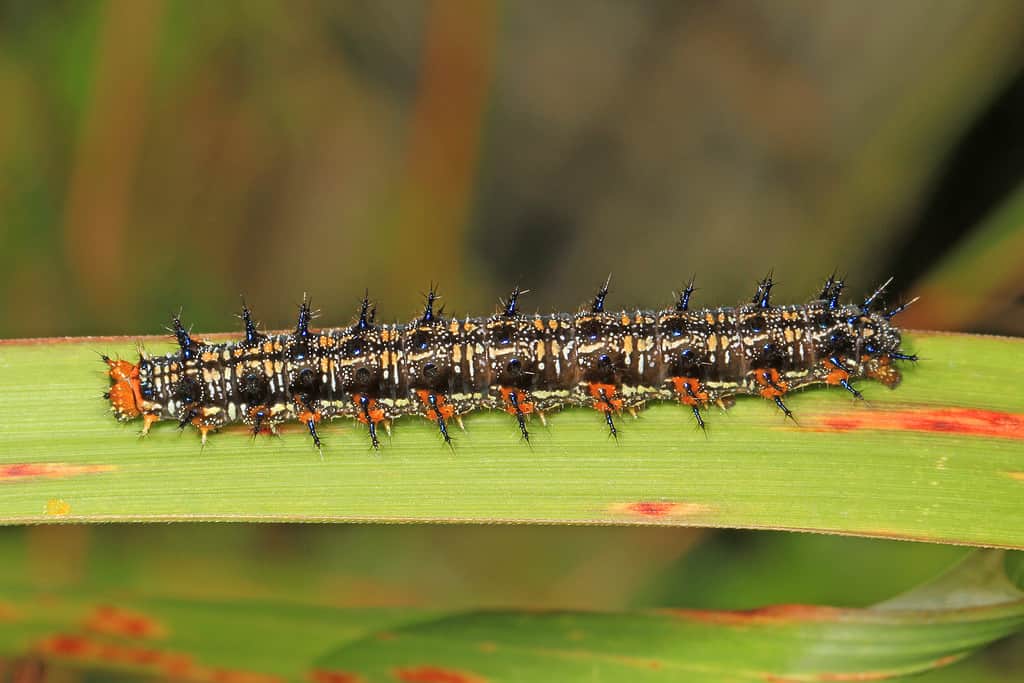
This spiky caterpillar may look intimidating, but it is not harmful.
©Judy Gallagher / CC BY 2.0 – License
The common buckeye caterpillars are some of the most spiky caterpillars found in North Carolina. Their striking appearance features a black base color adorned with stripes of white or brown. The caterpillar’s body is covered with black spines, acting as a deterrent to predators. These spines, while they may look threatening are not poisonous or harmful to humans.
The mature form of this species is predominantly a brown butterfly.
While they can live on a variety of short, broad-leaf plants, plantain is their preferred choice, offering the most nutritional benefits.
7. Spun Glass Slug (Isochaetes beutenmuelleri)
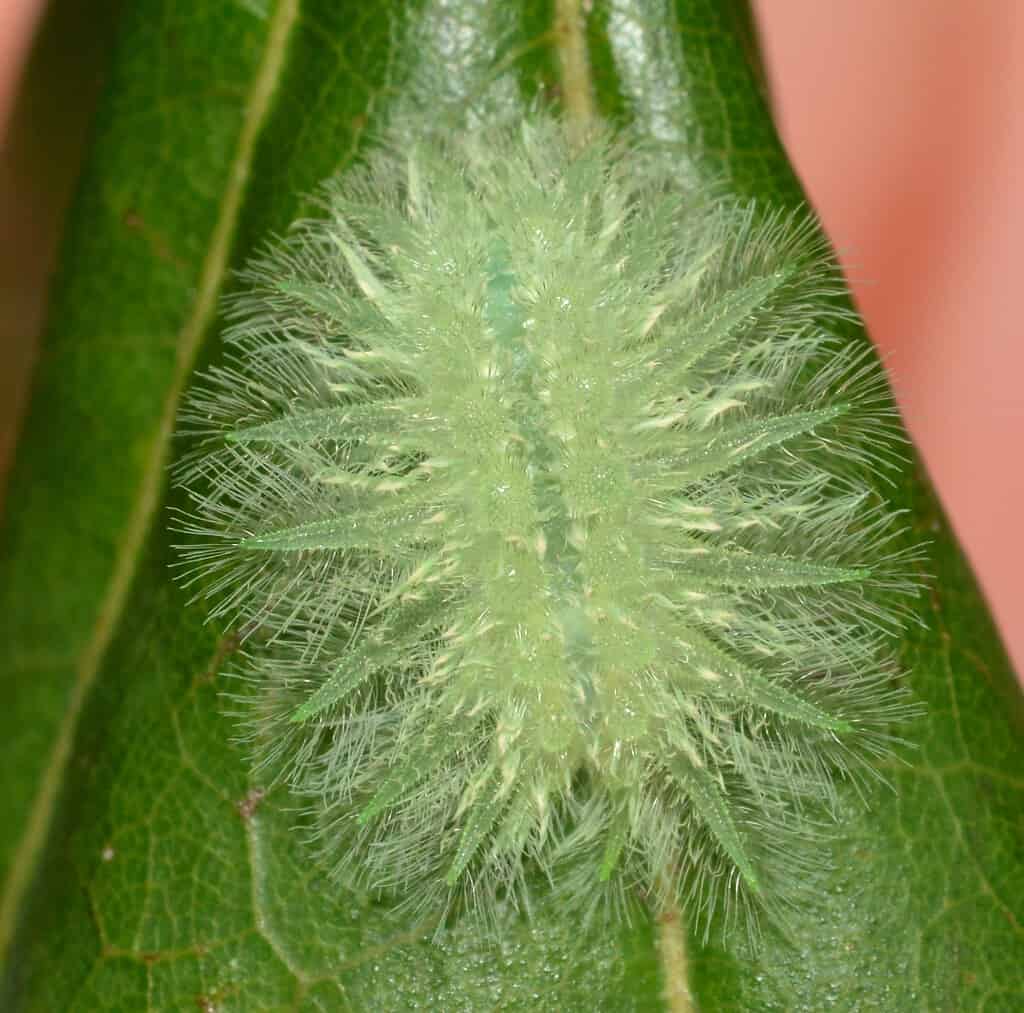
This is one of the most unique caterpillar species found in North Carolina. It looks more like a close-up of an algae bloom than a caterpillar!
©Andy Reago & Chrissy McClarren / CC BY 2.0 – License
Spun glass slug caterpillars have such a delicate appearance with their complex appendages that they could easily be mistaken for Christmas decorations if found on a holiday tree instead of their preferred habitat, the swamp oak tree.
Their almost transparent bodies are adorned with numerous crystal-like spikes. Despite their beauty, these caterpillars pose a significant threat. Touching their crystalline spikes can cause skin penetration, leading to a painful sting and varying severity of skin rashes. Additionally, they can produce toxins from their spikes, which could prove fatal to certain creatures.
8. Walnut Caterpillar (Datana integerrima)

These grey and red fuzzy caterpillars inhabit walnut and pecan trees and do not sting.
©Katja Schulz from Washington, D. C., USA / CC BY 2.0 – License
The walnut caterpillar inhabits a variety of woody plants and trees, including pecan, walnut, and hickory. In its larval stage, the caterpillar exhibits a color transition from reddish-brown to black, adorned with grayish stripes and hairs. These caterpillars can grow up to two inches in length.
Walnut caterpillars neither sting nor carry poison. They consume a variety of trees and shrubs. While you can find the walnut caterpillar, In North Carolina, it is rare.
9. Black Swallowtail Caterpillar (Papilio polyxenes)
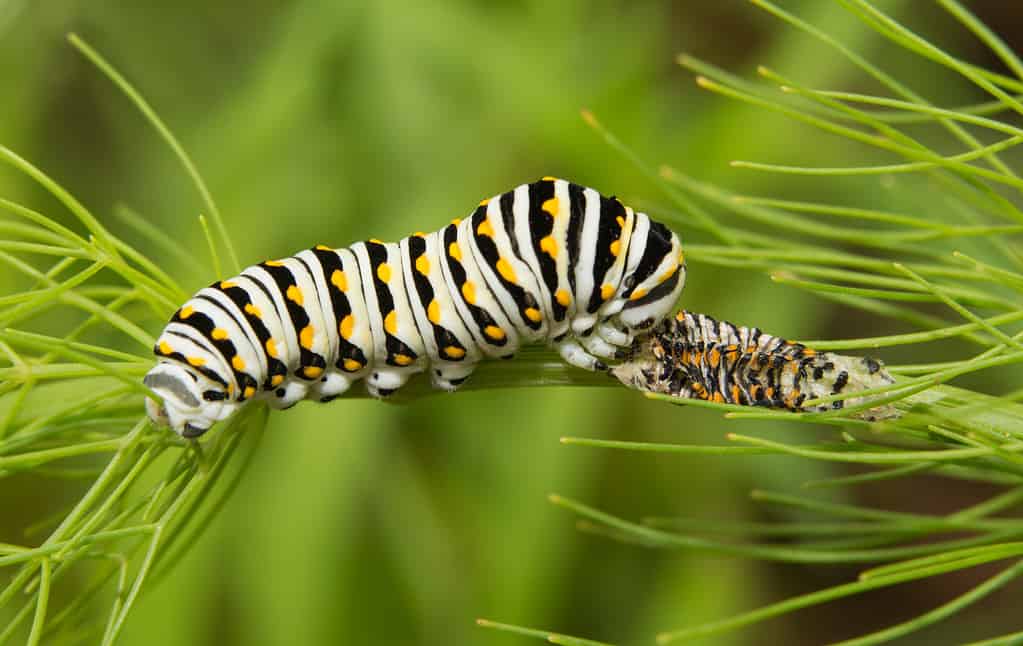
Despite being called the “black” swallowtail, this caterpillar is very colorful.
©Sari ONeal/Shutterstock.com
In North Carolina, several kinds of native and non-native wild carrots host the black swallowtail caterpillar. This species is known to inhabit plants such as mock bishopweed and poison hemlock, among other herb varieties.
The black swallowtail caterpillar is only black during its early development stages. Later on, it adds a white color to its initial black hue, eventually transforming into a green caterpillar with black bands and yellow spots at its mature stage. This caterpillar can destroy its environment. Its impact ranges from minimal to severe defoliation, affecting both the flowers and leaves of its host plants.
10. Great Spangled Fritillary Caterpillar (Speyeria cybele)
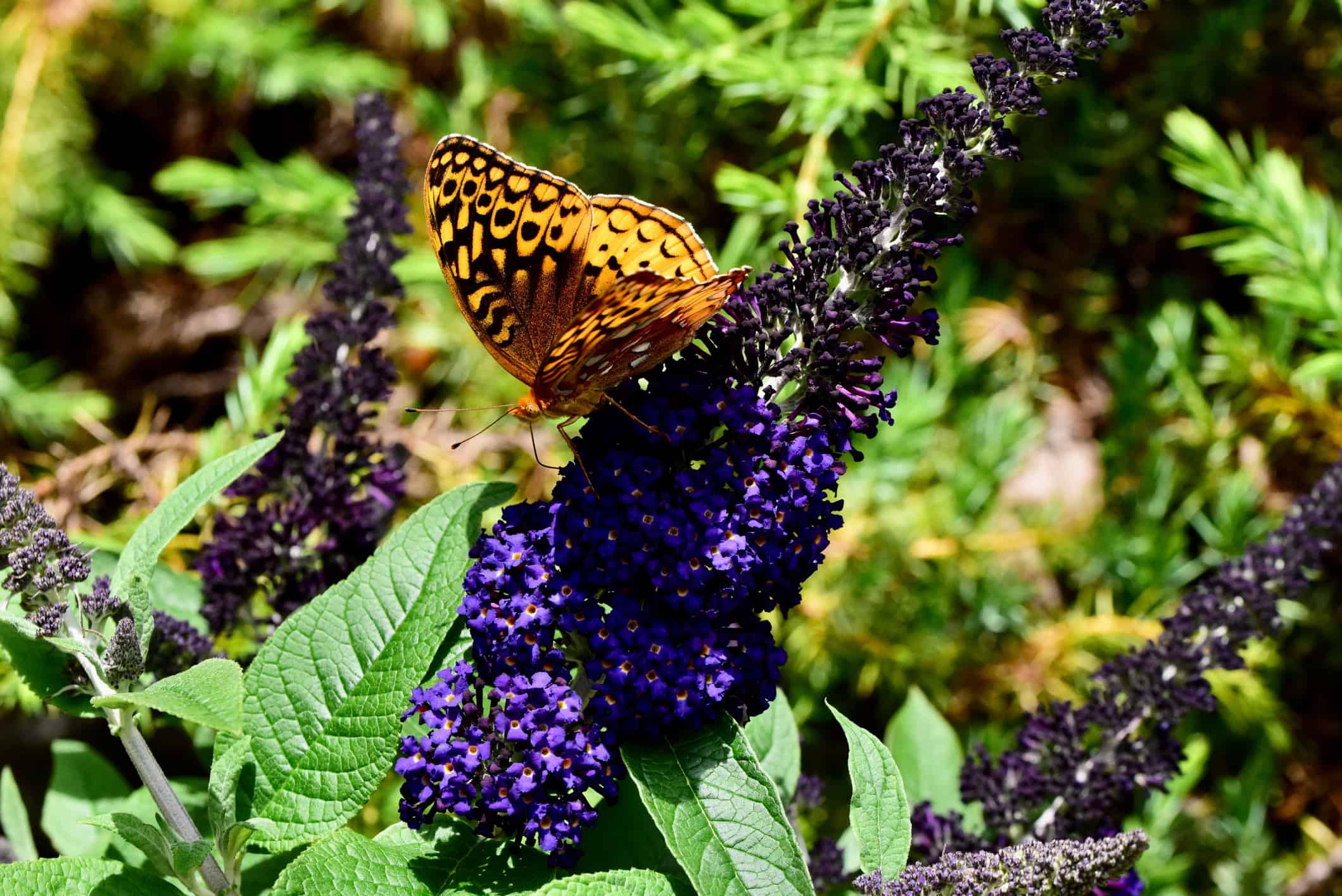
This butterfly is the adult version of the great spangled fritillary caterpillar.
©Wirestock/ via Getty Images
The great spangled fritillary caterpillar is characterized by its black hue punctuated with brown spots. North Carolina marks the eastern boundary of its distribution, as this species is prevalent across numerous U.S. states.
This particular caterpillar species exclusively feeds on violets. It uses a variety of violets as hosts, showing less preference for other plant types. The great spangled fritillary caterpillar is non-toxic and doesn’t pose a threat to human health.
11. American Dagger Caterpillar (Acronicta Americana)
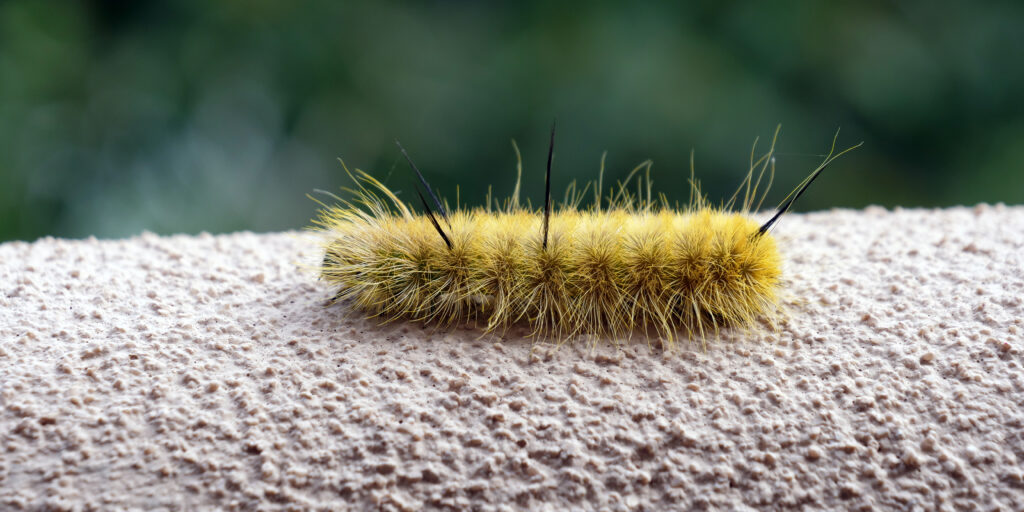
American Dagger Caterpillars are extremely toxic and can be a significant threat to children.
©Martha Marks/Shutterstock.com
Among the most unique species found in North Carolina is the American dagger caterpillar. Initially displaying a yellow and black body, it develops long yellow hairs as it matures. Its only habitat in the state is woodlands, with a dietary preference for deciduous broadleaf trees, notably hazel, hickory, and walnut.
The American dagger moth caterpillars are toxic to both humans and pets but pose a greater risk to humans, especially children, who might touch them while playing in a park.
12. Question Mark Caterpillar (Polygonia interrogations)
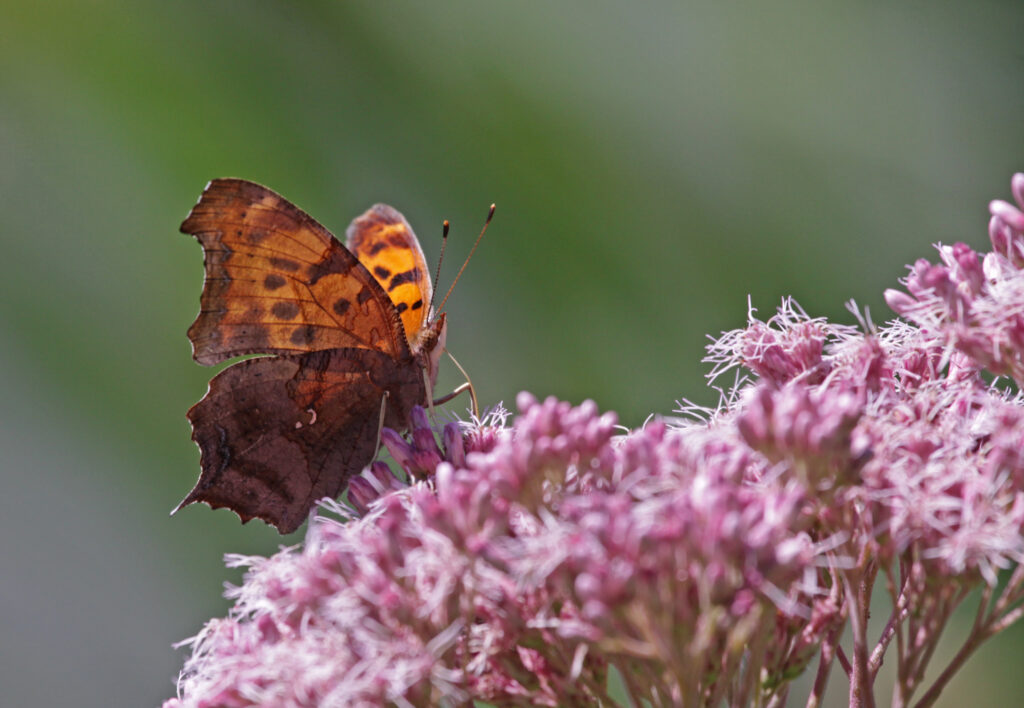
The butterfly of the question mark caterpillar has unique markings on the back of its wings.
©Chris Hill/Shutterstock.com
The question mark caterpillar stands out with its unique orange and black hues. Its dominant black body features shades of orange, brown-orange, or red-orange. This species has a significant impact on the American Elm, with occasional outbreaks causing partial defoliation of trees.
Covered in colorful spines, the caterpillar has a natural defense against predators. These spines, however, are not venomous.
While it’s commonly found on the leaves of local elm trees, it can also be spotted on false nettle.
Fun fact: The question mark butterfly, which is the adult of the caterpillar, has a unique dotted and dashed pattern on its wings, which is why it is called the “question mark” butterfly.
13. Red Admiral Caterpillar (Vanessa atalanta)
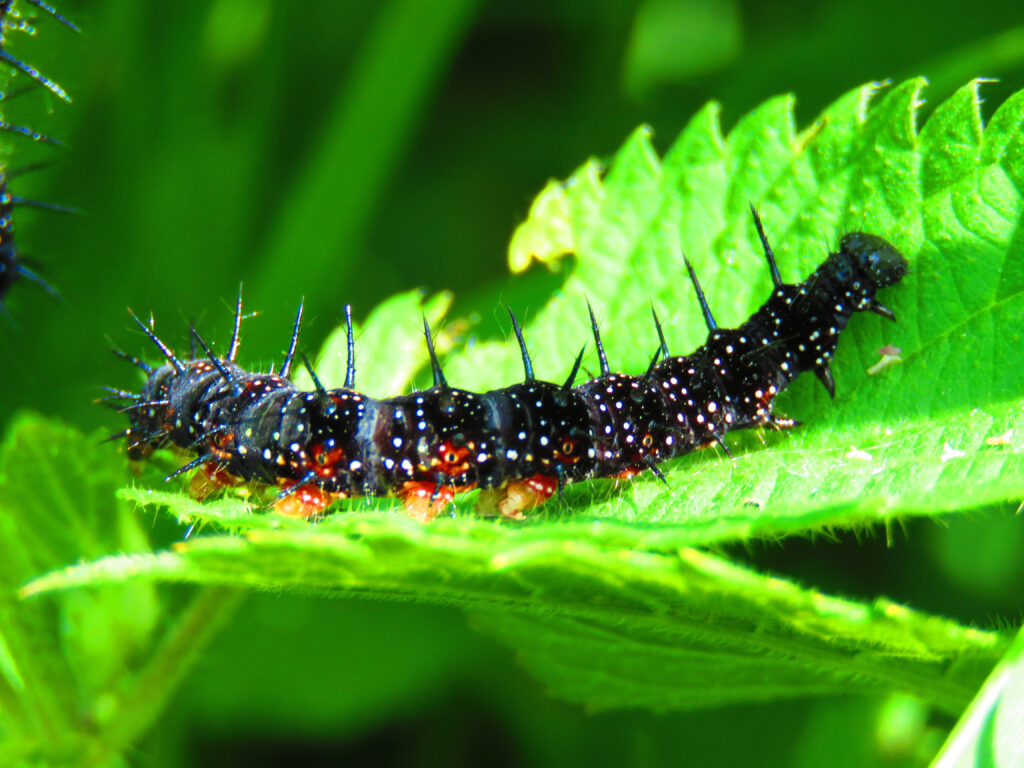
While they are called red admirals, this caterpillar is not red. In reality, it is black with white and orange markings.
©Przemyslaw Muszynski/Shutterstock.com
Red admirals, among the most frequently spotted migratory butterflies in North Carolina, owe their common appearance to favorable weather and abundant food sources.
Mainly black in color, they match the dark hues found on the butterfly’s wings. The caterpillar’s body, during all growth stages, is covered in black spines.
Stinging nettle serves as one of their hosts, significantly influencing red admiral migration patterns. Despite their intimidating appearance, these caterpillars are actually harmless and safe to handle.
14. Yellow Woolly Bear Caterpillar (Spilosoma virginica)
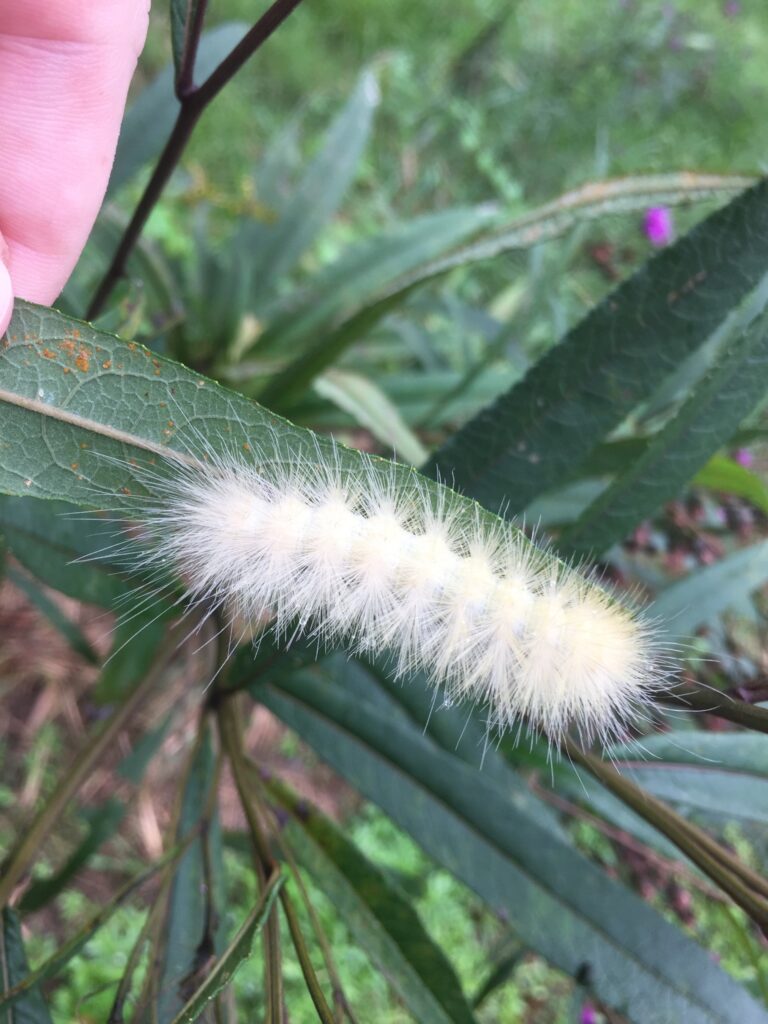
This fuzzy caterpillar eventually grows to become the Virginia tiger moth, though the caterpillar can also be found in North Carolina.
©35° 55′ 58.87″ N, 78° 56′ 37.5″ W Kartographer map based on OpenStreetMap. – License
The yellow woolly bear caterpillar sports a light yellow color and a fuzzy body. These caterpillars feed on a range of plants, including clover, and though generally harmless, their feeding can significantly affect plant health by summer’s end.
While they may cause skin allergies in a handful of individuals, most encounters are harmless.
15. Spiny Oak Slug Caterpillar (Euclea delphinii)
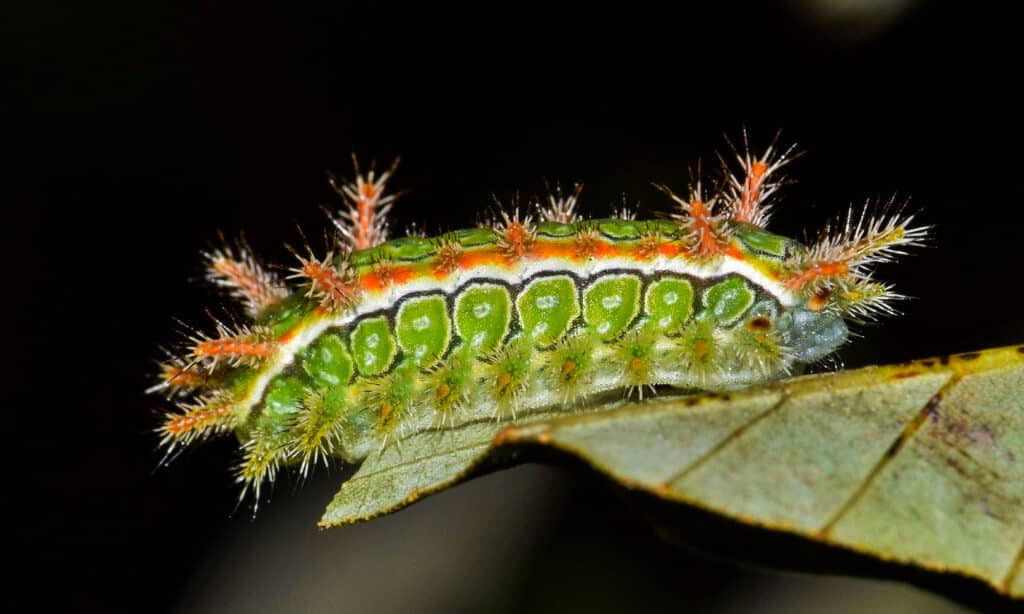
This caterpillar is referred to as a slug because of the irregularity in its legs that makes it look slug-like.
©iStock.com/Brett_Hondow
Nicknamed “slug” due to their short prolegs and lack of tiny abdominal hooks typical in most caterpillars, spiny oak slug caterpillars exhibit a unique appearance. They feature a greenish body with a dark, blotchy stripe on their back and two rows of spiny, yellowish lobes on each side.
Their diet comprises various trees, such as oaks, apples, maples, and plums. While these caterpillars do possess spines filled with toxins, their stings are less intense compared to other stinging caterpillars.
16. Crowned Slug Caterpillar (Isa textual)
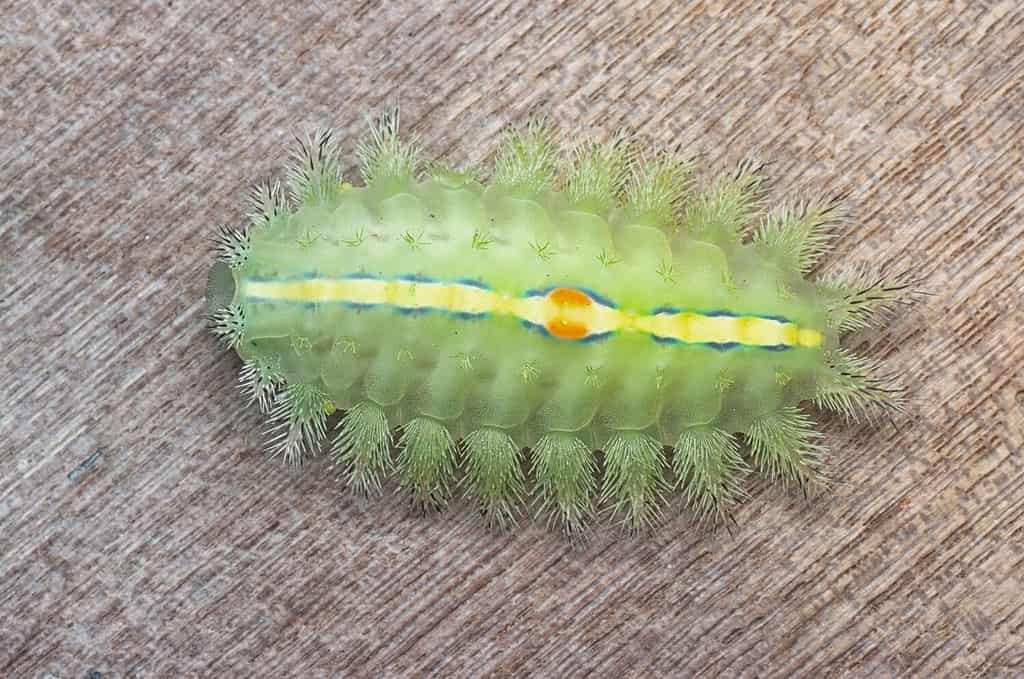
Another caterpillar in North Carolina that is extremely unique in appearance is the crowned slug caterpillar.
©Young Swee Ming/Shutterstock.com
Among the caterpillars found in the animal kingdom, the crowned slug caterpillar stands out due to its stunning appearance. Their pastel green, flattened, oval bodies are adorned with rings of stinging hairs along the edges and less noticeable stinging hairs on top. They thrive on various hardwoods, such as cherry, hickory, linden, oak, Norway maple, and other trees and shrubs.
While the adult versions are harmless, these caterpillars are known for their sting. Upon touch, their venomous hairs break off and penetrate the offender’s skin.
17. Silver-Spotted Skipper Caterpillar (Silver-Spotted Skipper Caterpillar)
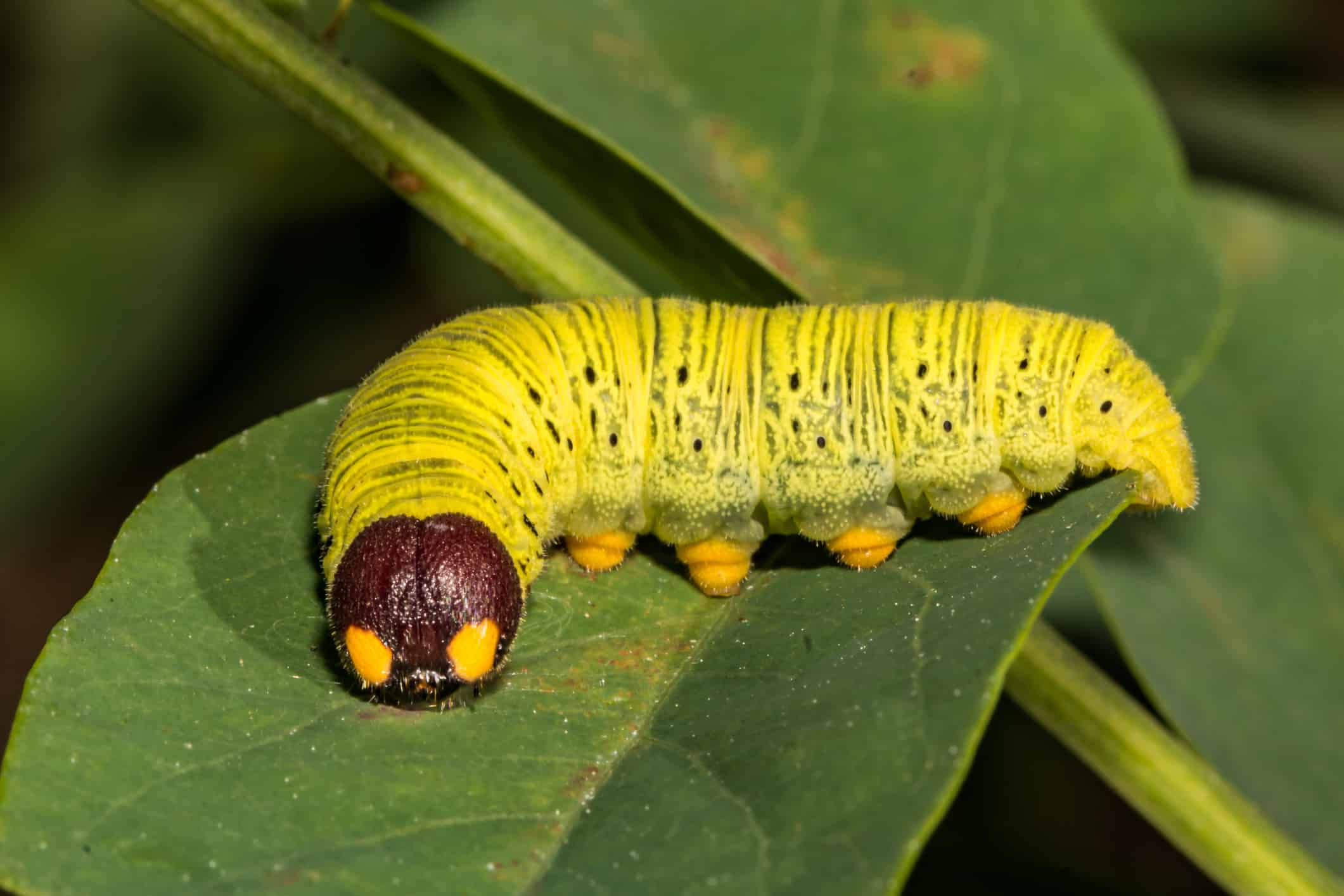
This intriguing caterpillar species has poisonous skin and can irritate your skin if you touch it.
©JasonOndreicka/ via Getty Images
The silver-spotted skipper caterpillar, distinguished by its yellow color and hefty, wider physique, dwells on various trees, herbs, and vines. It has a dark brown head, with its eyes and prolegs tinted in orange.
While it can be occasionally harmful to certain crops, like soybeans and kidney beans, its overall threat level is relatively low. However, one should exercise caution, as the silver-spotted skipper caterpillar is poisonous, and known to cause intense skin irritation.
18. Monarch Caterpillar (Danaus plexippus)
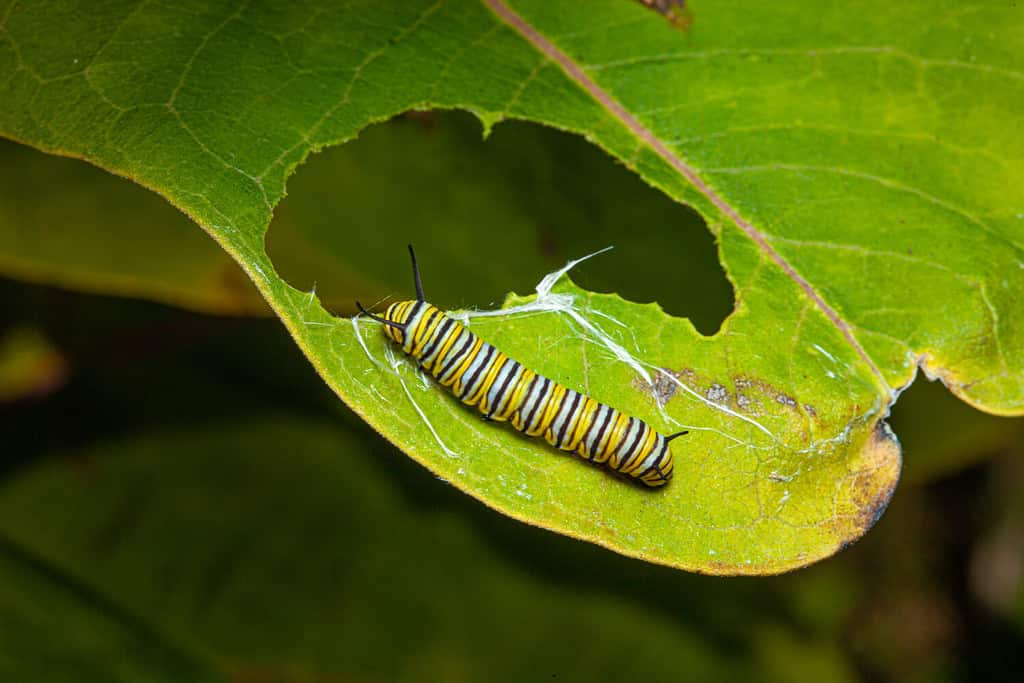
Monarch butterflies are some of the most common and beautiful butterflies in North America. This is the caterpillar of the species.
©K Hanley CHDPhoto/Shutterstock.com
The monarch caterpillar is a widespread species in North Carolina. Boasting a distinct pattern of yellow, black, and white stripes and reaching lengths of two inches prior to metamorphosis, they exhibit antennae-like tentacles at both ends of their body.
Though they primarily feed on common milkweed, these caterpillars can adapt to various host plants. Be aware they are among the toxic caterpillars found in North Carolina!
19. Polyphemus Moth Caterpillar (Antheraea polyphemus)

This is the
Polyphemus moth
caterpillar. It goes through many color variations throughout its life cycle.
©Brett Hondow/Shutterstock.com
The Polyphemus moth caterpillar is a large, fuzzy species that experiences significant color changes throughout its growth, often leading to confusion with the likes of monarch caterpillars.
Initially, this caterpillar exhibits a white body accented with black bands, yellow sections, and a brown head. As it matures, it takes on a green color with tiny brown spots sprinkled across its body. Though common in North Carolina, these caterpillars aren’t deemed pests. However, in California, they pose a threat to cultivated plum trees by consuming the leaves.
While not poisonous, handling them can lead to skin irritation.
20. Cloudless Sulfur Caterpillar (Phoebis sennae)
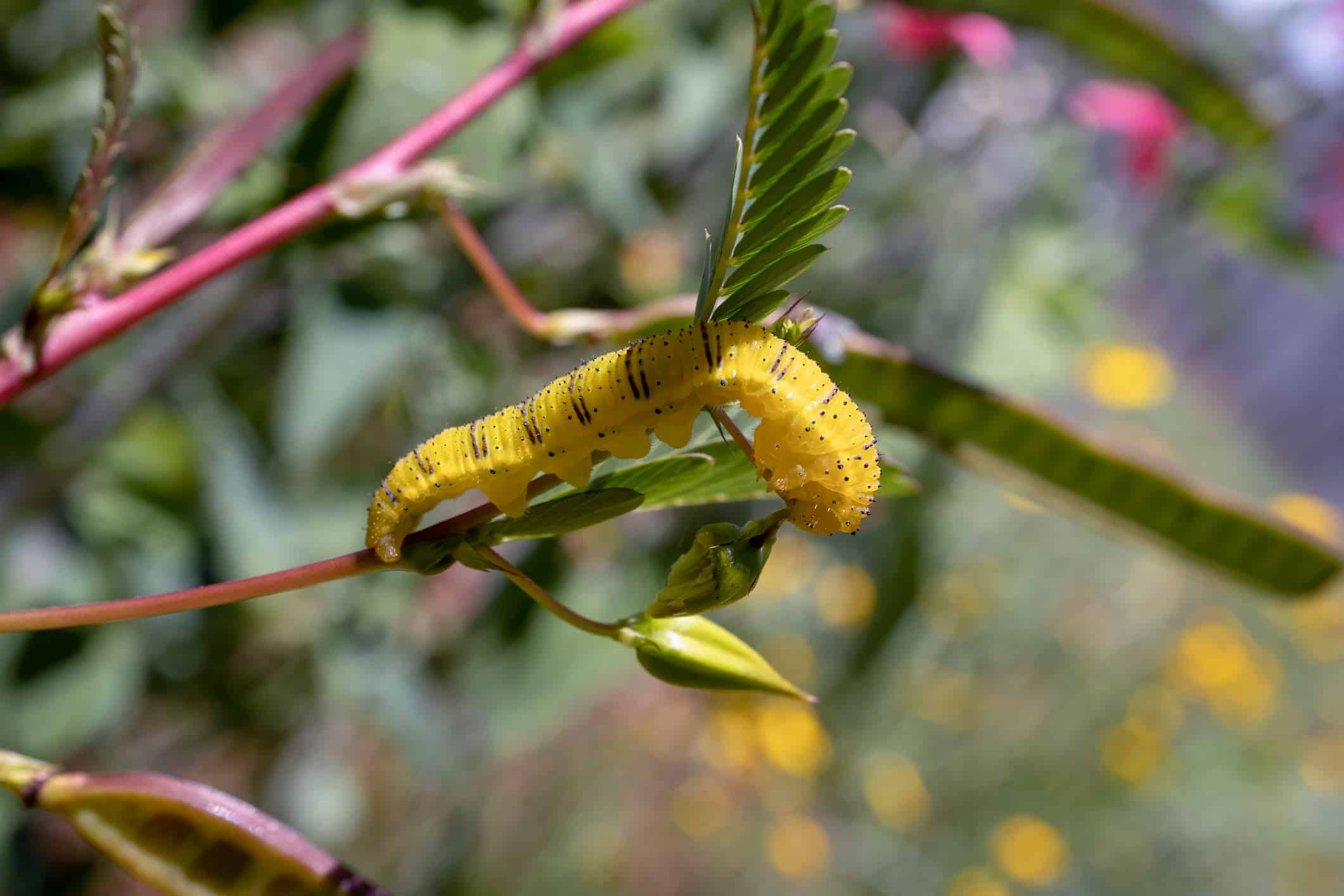
This caterpillar starts life as a bright yellow color to help disguise it in pea flowers.
©DrWD40/ via Getty Images
The cloudless sulfur caterpillar, known for its vibrant green or yellow hues, has established communities throughout North Carolina. The caterpillar’s colors mimic the sensitive pea plant, a favored host. Beginning life as yellow, it transitions to green, with yellow noticeable on its body’s side bands. The mature stage sees a return to yellow, and the pupa may exhibit green, yellow-green, or pink and yellow shades.
Prior to turning into a sulfur butterfly, the caterpillar feasts on Cassia and Senna leaves and flowers, which are poisonous, thus allowing it to accumulate toxic deterrents against potential predators.
Regions in North Carolina with the Most Caterpillars
North Carolina’s diverse ecosystem is home to a wide array of caterpillar species. Areas with the most caterpillars tend to be those abundant in greenery and plant life. In the Blue Ridge Mountains, caterpillars flourish amidst lush forests and vibrant flowering plants. The Piedmont region, with its mix of urban and rural landscapes, also hosts a variety of species, especially in park areas.
Nantahala National Forest is also an ideal place for caterpillars, especially in areas with preserved natural habitats. Remember, where there’s abundant plant life, caterpillars aren’t far behind!
Summary of 20 Caterpillars Found in North Carolina
| Rank | Caterpillar | Type of Caterpillar | Poisonous/Venomous? |
|---|---|---|---|
| 1 | Buck Moth Caterpillar | Moth | Venomous |
| 2 | Pipevine Swallowtail | Butterfly | Poisonous |
| 3 | Saddleback Caterpillar | Moth | Venomous |
| 4 | Milkweed Tussock Caterpillar | Moth | Slightly Venomous, causes rashes |
| 5 | Spicebush Swallowtail | Butterfly | No |
| 6 | Common Buckeye Caterpillar | Butterfly | No |
| 7 | Spun Glass Slug | Moth | Poisonous |
| 8 | Walnut Caterpillar | Moth | No |
| 9 | Black Swallowtail Caterpillar | Butterfly | No |
| 10 | Great Spangled Fritillary | Butterfly | No |
| 11 | American Dagger Caterpillar | Moth | Venomous |
| 12 | Question Mark Caterpillar | Butterfly | No |
| 13 | Red Admiral Caterpillar | Butterfly | No |
| 14 | Yellow Woolly Bear Caterpillar | Moth | No |
| 15 | Spiny Oak Slug Caterpillar | Moth | Venomous |
| 16 | Crowned Slug Caterpillar | Moth | Venomous |
| 17 | Silver-Spotted Skipper Caterpillar | Butterfly | Poisonous |
| 18 | Monarch Caterpillar | Butterfly | Poisonous |
| 19 | Polyphemus Moth Caterpillar | Moth | No, but can cause skin irritation |
| 20 | Cloudless Sulphur Caterpillar | Butterfly | Poisonous |
The photo featured at the top of this post is © JasonOndreicka/ via Getty Images
Thank you for reading! Have some feedback for us? Contact the AZ Animals editorial team.






